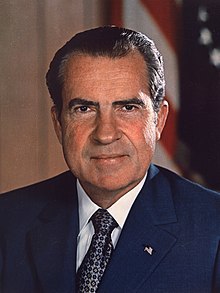
Back رئاسة ريتشارد نيكسون Arabic Kabinett Nixon German Richard Nixonin hallitus Finnish Présidence de Richard Nixon French הקבינט של ארצות הברית בממשל ריצ'רד ניקסון HE Presidenza di Richard Nixon Italian Kabinet-Nixon Dutch Президентство Річарда Ніксона Ukrainian
 | |
| Presidency of Richard Nixon January 20, 1969 – August 9, 1974[1] | |
| Cabinet | See list |
|---|---|
| Party | Republican |
| Election | |
| Seat | White House |
|
| |
| Library website | |
| ||
|---|---|---|
|
Pre-vice presidency 36th Vice President of the United States Post-vice presidency 37th President of the United States
Judicial appointments Policies First term Second term Post-presidency Presidential campaigns Vice presidential campaigns
 |
||
Richard Nixon's tenure as the 37th president of the United States began with his first inauguration on January 20, 1969, and ended when he resigned on August 9, 1974, in the face of almost certain impeachment and removal from office, the only U.S. president ever to do so. He was succeeded by Gerald Ford, whom he had appointed vice president after Spiro Agnew became embroiled in a separate corruption scandal and was forced to resign. Nixon, a prominent member of the Republican Party from California who previously served as vice president for two terms under president Dwight D. Eisenhower from 1953 to 1961, took office following his narrow victory over Democratic incumbent vice president Hubert Humphrey and American Independent Party nominee George Wallace in the 1968 presidential election. Four years later, in the 1972 presidential election, he defeated Democratic nominee George McGovern, to win re-election in a landslide. Although he had built his reputation as a very active Republican campaigner, Nixon downplayed partisanship in his 1972 landslide re-election.
Nixon's primary focus while in office was on foreign affairs. He focused on détente with the People's Republic of China and the Soviet Union, easing Cold War tensions with both countries. As part of this policy, Nixon signed the Anti-Ballistic Missile Treaty and SALT I, two landmark arms control treaties with the Soviet Union. Nixon promulgated the Nixon Doctrine, which called for indirect assistance by the United States rather than direct U.S. commitments as seen in the ongoing Vietnam War. After extensive negotiations with North Vietnam, Nixon withdrew the last U.S. soldiers from South Vietnam in 1973, ending the military draft that same year. To prevent the possibility of further U.S. intervention in Vietnam, Congress passed the War Powers Resolution over Nixon's veto.
In domestic affairs, Nixon advocated a policy of "New Federalism", in which federal powers and responsibilities would be shifted to state governments. However, he faced a Democratic Congress that did not share his goals and, in some cases, enacted legislation over his veto. Nixon's proposed reform of federal welfare programs did not pass Congress, but Congress did adopt one aspect of his proposal in the form of Supplemental Security Income, which provides aid to low-income individuals who are aged or disabled. The Nixon administration adopted a "low profile" on school desegregation, but the administration enforced court desegregation orders and implemented the first affirmative action plan in the United States. Nixon also presided over the creation of the Environmental Protection Agency and the passage of major environmental laws like the Clean Water Act, although that law was vetoed by Nixon and passed by override. Economically, the Nixon years saw the start of a period of "stagflation" that would continue into the 1970s.
Nixon was far ahead in the polls in the 1972 presidential election, but during the campaign, Nixon operatives conducted several illegal operations designed to undermine the opposition. They were exposed when the break-in of the Democratic National Committee Headquarters ended in the arrest of five burglars. This kicked off the Watergate Scandal and gave rise to a congressional investigation. Nixon denied any involvement in the break-in. However, after a tape emerged revealing that Nixon had known about the White House connection to the burglaries shortly after they occurred, the House of Representatives initiated impeachment proceedings. Facing removal by Congress, Nixon resigned from office.
Though some scholars believe that Nixon "has been excessively maligned for his faults and inadequately recognised for his virtues",[2] Nixon is generally ranked as a below average president in surveys of historians and political scientists.[3][4][5]
- ^ Resigned from office
- ^ Aitken, p. 577.
- ^ Cite error: The named reference
brottinghauswas invoked but never defined (see the help page). - ^ Cite error: The named reference
Sienawas invoked but never defined (see the help page). - ^ Cite error: The named reference
cspanrankingswas invoked but never defined (see the help page).

